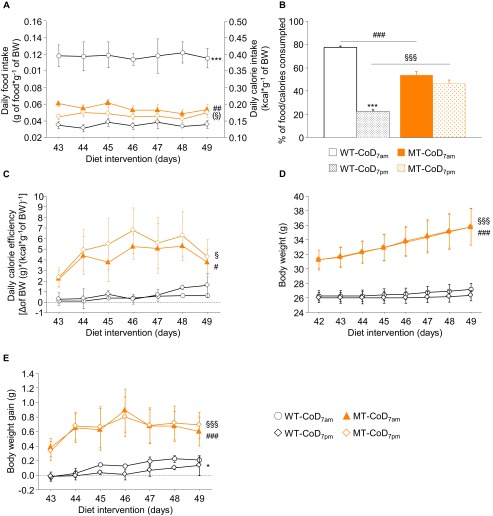Fig. S3.
Eating habits in CoD-fed male MT mice. (A) Daily food and calorie intake was monitored during the last week of the diet-intervention study (6–7 wk of diet intervention;11–12 wk of age) in CoD-fed male SNAP-25b–deficient mice and the corresponding WT littermates. The absolute values of food and calorie intake were corrected by the body weight of the animals. (B) The measurement of these parameters reveals that WT mice under physiological conditions consumed 77.56 ± 1.28% of the daily amount of food and calories during the dark period, and only 22.44 ± 1.27% during the day. In contrast, male MT mice consumed approximately the same amount of food and calories during the light (53.64 ± 2.90%) and dark (46.36 ± 2.92%) hours, suggesting that the obese phenotype that developed in CoD-fed male MT mice resulted from impaired eating behavior. (C) Daily calorie efficiency was calculated using the formula: Δ body weight (in grams)/[daily calorie intake (in kilocalories)/body weight (in grams)]. (D and E) Body weight (D) and body weight gain (E) were determined in CoD-fed male SNAP-25b–deficient mice and their WT littermates in the same week and in the same light and dark periods as specified for the daily food and calorie intake. WT/MT-CoD7:00 PM vs. WT/MT-CoD7:00 AM: *P < 0.05; ***P < 0.001; MT-CoD7:00 PM vs. WT-CoD7:00 PM: ##P < 0.01; ###P < 0.001; MT-CoD7:00 AM vs. WT-CoD7:00 AM: §P < 0.05; §§P < 0.01; §§§P < 0.001. (This figure is related to Fig. 1E.)

